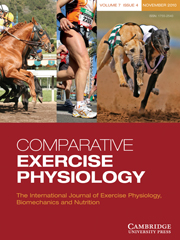Crossref Citations
This article has been cited by the following publications. This list is generated based on data provided by
Crossref.
Poole, David C.
2010.
Letter to Editor: Lamprecht et al. Inflammatory responses to three modes of intense exercise in Standardbred mares – a pilot study.
Comparative Exercise Physiology,
Vol. 7,
Issue. 03,
p.
149.
WILLIAMS, C. A.
and
BURK, A. O.
2010.
Nutrient intake during an elite level three‐day event competition is correlated to inflammatory markers and antioxidant status.
Equine Veterinary Journal,
Vol. 42,
Issue. s38,
p.
116.
Lamprecht, Emily
Bagnell, Carol
and
Williams, Carey
2010.
Rebuttal Letter to editor - Lamprecht et al. Inflammatory responses to three modes of intense exercise in standardbred mares - a pilot study.
Comparative Exercise Physiology,
Vol. 7,
Issue. 03,
p.
151.
Horohov, David W.
Sinatra, Stephen T.
Chopra, Raj K.
Jankowitz, Stanley
Betancourt, Alejandra
and
Bloomer, Richard J.
2012.
The Effect of Exercise and Nutritional Supplementation on Proinflammatory Cytokine Expression in Young Racehorses During Training.
Journal of Equine Veterinary Science,
Vol. 32,
Issue. 12,
p.
805.
Lamprecht, Emily D.
and
Williams, Carey A.
2012.
Biomarkers of Antioxidant Status, Inflammation, and Cartilage Metabolism Are Affected by Acute Intense Exercise but Not Superoxide Dismutase Supplementation in Horses.
Oxidative Medicine and Cellular Longevity,
Vol. 2012,
Issue. ,
p.
1.
Adamu, L.
Noraniza, M.A.
Rasedee, A.
and
Bashir, A.
2013.
Metabolic responses of acute phase protein, antioxidant and cytokine in Arabian Endurance horses.
Comparative Exercise Physiology,
Vol. 9,
Issue. 1,
p.
51.
Song, Ki-Duk
Cho, Hyun-Woo
Lee, Hak-Kyo
and
Cho, Byung Wook
2014.
Molecular Characterization and Expression Analysis of Equine <i>Vascular Endothelial Growth Factor Alpha</i> (<i>VEGFα</i>) Gene in Horse (<i>Equus caballus</i>).
Asian-Australasian Journal of Animal Sciences,
Vol. 27,
Issue. 5,
p.
743.
Sinatra, Stephen T.
Jankowitz, Stanley N.
Chopra, Raj K.
and
Bhagavan, Hemmi N.
2014.
Plasma Coenzyme Q10 and Tocopherols in Thoroughbred Race Horses: Effect of Coenzyme Q10 Supplementation and Exercise.
Journal of Equine Veterinary Science,
Vol. 34,
Issue. 2,
p.
265.
Turło, Agnieszka
Cywińska, Anna
Czopowicz, Michał
Witkowski, Lucjan
Niedźwiedź, Artur
Słowikowska, Malwina
Borowicz, Hieronim
Jaśkiewicz, Anna
Winnicka, Anna
and
Reddy, Hemachandra
2015.
The Effect of Different Types of Musculoskeletal Injuries on Blood Concentration of Serum Amyloid A in Thoroughbred Racehorses.
PLOS ONE,
Vol. 10,
Issue. 10,
p.
e0140673.
Turlo, A.
Cywinska, A.
Czopowicz, M.
Witkowski, L.
Szarska, E.
and
Winnicka, A.
2015.
Post-exercise dynamics of serum amyloid A blood concentration in thoroughbred horses classified as injured and non-injured after the race.
Research in Veterinary Science,
Vol. 100,
Issue. ,
p.
223.
Smarsh, Danielle N.
and
Williams, Carey A.
2016.
Oxidative Stress and Antioxidant Status in Standardbreds: Effect of Age and Acute Exercise Before and After Training.
Journal of Equine Veterinary Science,
Vol. 47,
Issue. ,
p.
92.
Page, Allen E.
Stewart, John C.
Holland, Robert E.
and
Horohov, David W.
2017.
The Impact of Training Regimen on the Inflammatory Response to Exercise in 2-Year-Old Thoroughbreds.
Journal of Equine Veterinary Science,
Vol. 58,
Issue. ,
p.
78.
te Moller, Nikae C.R.
and
van Weeren, P. René
2017.
How exercise influences equine joint homeostasis.
The Veterinary Journal,
Vol. 222,
Issue. ,
p.
60.
Lindinger, Michael I.
MacNicol, Jennifer M.
Karrow, Neil
and
Pearson, Wendy
2017.
Effects of a Novel Dietary Supplement on Indices of Muscle Injury and Articular GAG Release in Horses.
Journal of Equine Veterinary Science,
Vol. 48,
Issue. ,
p.
52.
MacNicol, Jennifer L.
Lindinger, Michael I.
and
Pearson, Wendy
2018.
A time-course evaluation of inflammatory and oxidative markers following high-intensity exercise in horses: a pilot study.
Journal of Applied Physiology,
Vol. 124,
Issue. 4,
p.
860.
Piccione, Giuseppe
Giannetto, Claudia
Bruschetta, Daniele
Congiu, Fulvio
Arfuso, Francesca
and
Giudice, Elisabetta
2019.
Influence of exercise and dietary omega-3 oil supplementation on interleukin 1-Ra serum concentrations in Standardbred horses.
Animal Production Science,
Vol. 59,
Issue. 2,
p.
232.
Page, A.E.
Stewart, J.C.
Scollay, M.C.
and
Horohov, D.W.
2020.
Comparison of pre-race inflammatory marker mRNA expression with race-related parameters in Thoroughbreds.
Comparative Exercise Physiology,
Vol. 16,
Issue. 2,
p.
101.
Valigura, Hannah C
Leatherwood, Jessica L
Martinez, Rafael E
Norton, Sharon A
and
White-Springer, Sarah H
2021.
Dietary supplementation of aSaccharomyces cerevisiaefermentation product attenuates exercise-induced stress markers in young horses.
Journal of Animal Science,
Vol. 99,
Issue. 8,
Page, Allen E.
Wood, Courtney
Partridge, Emma
Horohov, David W.
and
Adam, Emma
2022.
Equine Peripheral Gene Expression Changes in Response to Dose-Dependent Lipopolysaccharide-Induced Synovitis.
Journal of Equine Veterinary Science,
Vol. 109,
Issue. ,
p.
103828.
Mowry, Kayla C.
Thomson-Parker, Timber L.
Morales, Cruz
Fikes, Kalley K.
Stutts, Kyle J.
Leatherwood, Jessica L.
Anderson, Mark J.
Smith, Rachelle X.
and
Suagee-Bedore, Jessica K.
2022.
Effects of Crude Rice Bran Oil and a Flaxseed Oil Blend in Young Horses Engaged in a Training Program.
Animals,
Vol. 12,
Issue. 21,
p.
3006.

